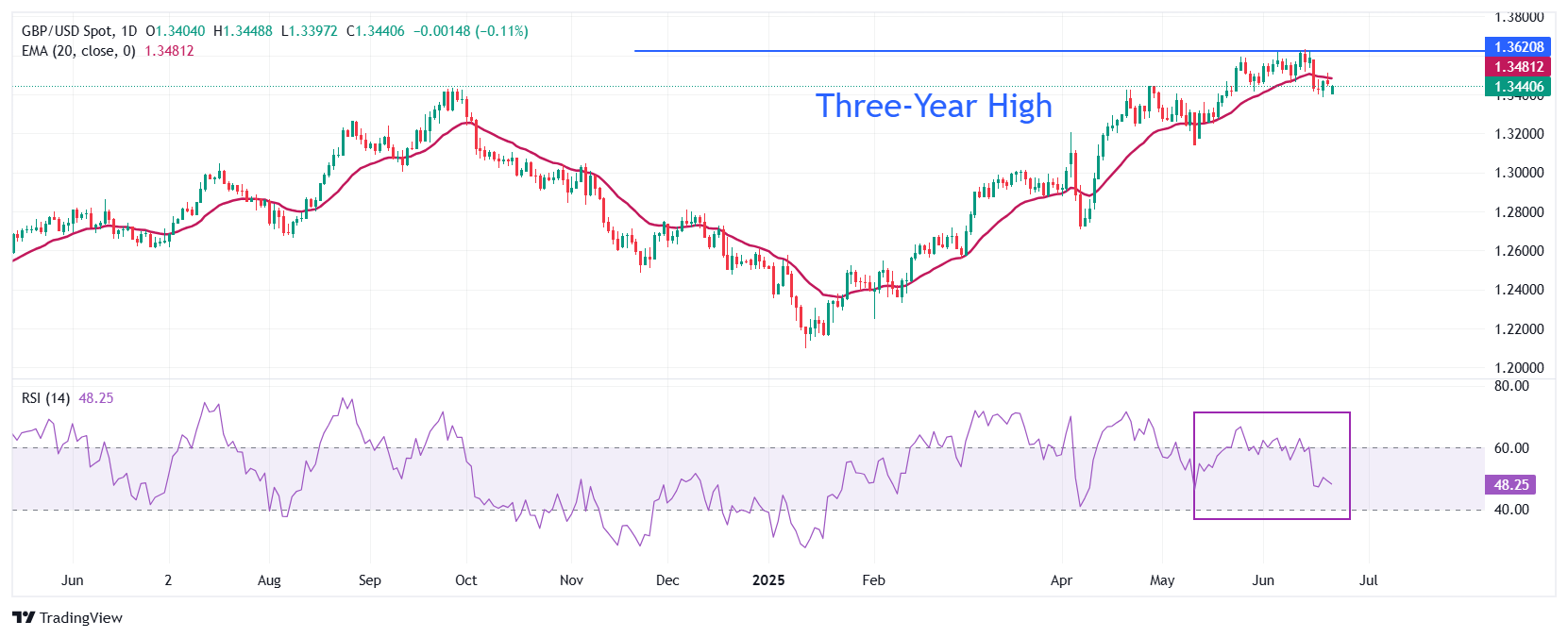Pound Sterling bounces back even as US-Iran tensions spoil market sentiment
- The Pound Sterling claws back its initial losses and flattens at around 1.3430 against the US Dollar.
- Market sentiment turns risk-averse as the US strikes Iran’s nuclear sites.
- Investors await the UK-US flash PMI data for June.
The Pound Sterling (GBP) recovers early losses and rebounds to near 1.3440 against the US Dollar (USD) during European trading hours on Monday. The GBP/USD pair attracts bids as the United States (US) attack on Iran appears to have triggered a muted response from markets so far
Investors shifted to the safe-haven fleet right at the opening of the week as the United States (US) unexpectedly struck Tehran’s three nuclear facilities over the weekend. However, safe-haven demand waned somewhat as the European session approached.
The demand for the US Dollar as a safe-haven asset increased as these tend to performs better in a geopolitical uncertain environment. During the European trading session, the US Dollar Index (DXY) trades higher around 99.00.
US President Donald Trump said on Truth.Social that Washington’s military forces have successfully demolished Iranian nuclear facilities: Fordow, Natanz, and Isfahan. Trump’s claim that Tehran’s nuclear sites have been destroyed has been challenged as Israeli officials have stated that Iran managed to shift its uranium stockpiles before the attack, according to the New York Times.
Investors brace for further weakness in riskier assets, such as the Pound Sterling, as Iran vows to retaliate against the US. Iran’s UN Ambassador Amir Saeid Iravani said in an emergency meeting of the United Nations (UN) Security Council on Sunday that the Iranian military will decide the “timing, nature and scale of Iran’s proportionate response”.
Meanwhile, the Iranian parliament has passed the proposal of closing the Strait of Hormuz to Iran’s Supreme National Security Council, a move that could potentially diminish the global Oil supply, Iran’s Press TV reported.
Daily digest market movers: Pound Sterling rebounds ahead of flash UK PMI data
- The Pound Sterling trades broadly unchanged against its peers on Monday amid a supportive BoE’s monetary policy outlook. The BoE maintained a “gradual and careful” monetary easing guidance on Thursday following the interest rate decision in which it held borrowing rates steady at 4.25%.
- BoE Governor Andrew Bailey said in a press conference that interest rates remain on a “gradual downward path”. Bailey also guided that the central bank will closely monitor softening labor market conditions and rising energy prices amid escalating Middle East tensions, which will be key risks to the economy.
- Meanwhile, investors await the flash S&P Global Purchasing Managers’ Index (PMI) data for June, which will be published at 08:30 GMT. The PMI data is expected to show that activityy in the services sector expanded at a faster pace, while the manufacturing sector activity declined but at a moderate pace. The Composite PMI is seen rising to 50.5 from 50.3 in May.
- In the US, investors also await the preliminary US S&P Global PMI data for June, which will be published at 13:45 GMT. Financial market participants will pay close attention to the impact of tariffs on input costs.
- Federal Reserve (Fed) Governor Christopher Waller argued on Friday in favor of an interest rate reduction in the July policy meeting. Waller stated that he expects limited impact of tariffs on inflation and warns of cracks in the labor market, which prompts the need for monetary policy expansion. “The tariffs should pose a one-off level effect on prices and not be a persistent boost to inflation," Waller said and added, “The Fed should not wait for the job market to crash in order to cut rates." FXStreet's Fedtracker, which gauges the tone of Fed officials' speeches on a dovish-to-hawkish scale from 0 to 10 using a custom AI model, rated Waller's words as dovish with a score of 3.4.
Technical Analysis: Pound Sterling recovers to near 1.3445

The Pound Sterling bounces back to near 1.3445 after a weak opening around 1.3400 against the US Dollar on Monday. However, its near-term trend remains bearish as the GBP/USD pair stays below the 20-day Exponential Moving Average (EMA) at around 1.3477.
The 14-day Relative Strength Index (RSI) oscillates inside the 40.00-60.00 range, close to the 50 neutral level, indicating a sideways performance in the near term.
Looking down, the May 16 low around 1.3250 will act as a key support zone. On the upside, the three-year high around 1.3630 will act as a key barrier.
Pound Sterling FAQs
The Pound Sterling (GBP) is the oldest currency in the world (886 AD) and the official currency of the United Kingdom. It is the fourth most traded unit for foreign exchange (FX) in the world, accounting for 12% of all transactions, averaging $630 billion a day, according to 2022 data. Its key trading pairs are GBP/USD, also known as ‘Cable’, which accounts for 11% of FX, GBP/JPY, or the ‘Dragon’ as it is known by traders (3%), and EUR/GBP (2%). The Pound Sterling is issued by the Bank of England (BoE).
The single most important factor influencing the value of the Pound Sterling is monetary policy decided by the Bank of England. The BoE bases its decisions on whether it has achieved its primary goal of “price stability” – a steady inflation rate of around 2%. Its primary tool for achieving this is the adjustment of interest rates. When inflation is too high, the BoE will try to rein it in by raising interest rates, making it more expensive for people and businesses to access credit. This is generally positive for GBP, as higher interest rates make the UK a more attractive place for global investors to park their money. When inflation falls too low it is a sign economic growth is slowing. In this scenario, the BoE will consider lowering interest rates to cheapen credit so businesses will borrow more to invest in growth-generating projects.
Data releases gauge the health of the economy and can impact the value of the Pound Sterling. Indicators such as GDP, Manufacturing and Services PMIs, and employment can all influence the direction of the GBP. A strong economy is good for Sterling. Not only does it attract more foreign investment but it may encourage the BoE to put up interest rates, which will directly strengthen GBP. Otherwise, if economic data is weak, the Pound Sterling is likely to fall.
Another significant data release for the Pound Sterling is the Trade Balance. This indicator measures the difference between what a country earns from its exports and what it spends on imports over a given period. If a country produces highly sought-after exports, its currency will benefit purely from the extra demand created from foreign buyers seeking to purchase these goods. Therefore, a positive net Trade Balance strengthens a currency and vice versa for a negative balance.

